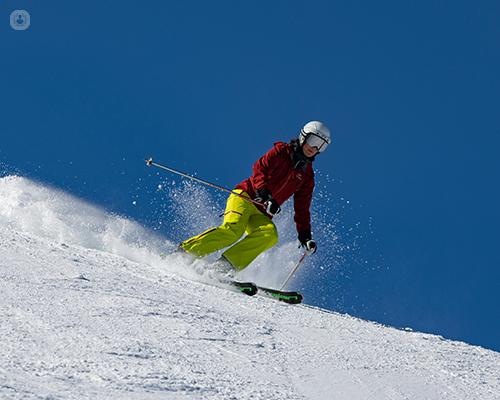Ski-related knee injuries: How to return to the slopes safely
Written in association with:From the crisp mountain air to the thrill of carving turns on powdery slopes, skiing is an exhilarating winter sport. However, as thrilling as skiing can be, the sport is also associated with certain risks, particularly to the knee.
Mr Deepu Sethi, leading specialist consultant orthopaedic knee surgeon, explains the most common ski-related knee injuries, discussing their causes, diagnosis, treatment, and prevention.

What are the 3 most common ski-related knee injuries?
The three most common knee injuries include:
ACL tears
ACL tears happen when the knee is forced into a twisting motion, such as during a sudden change in direction, a bad jump, or after a fall where the ski fails to release. Symptoms include a popping sound at the time of injury, immediate swelling and pain, difficulty bearing weight, and a feeling of instability in the knee.
MCL tears
MCL tears happen when the knee is forced inward, such as when the skis cross during a fall or collision. This injury can range from mild to severe, with symptoms including pain along the inside of the knee, swelling, and limited mobility. In more severe cases, instability may be present.
Meniscus tears
Meniscus tears are caused by twisting or pivoting motions, such as when a skier turns sharply while the foot is anchored. Symptoms include pain, swelling, stiffness, and a catching or “locking” sensation in the knee, as the torn cartilage can interfere with joint mechanics.
How is a ski-related knee injury diagnosed and treated?
Prompt evaluation by a healthcare professional, such as an orthopaedic surgeon, is essential.
Your orthopaedic surgeon will typically begin with a detailed medical history and a physical examination to assess the knee’s range of motion, stability, and areas of swelling or tenderness. Imaging tests, including X-rays or MRI scans, will also be used to confirm the extent of the injury and rule out issues like fractures.
Treatment will depend on the type and severity of the knee injury:
- For mild injuries, conservative measures like RICE (rest, ice application, compression, and elevation) are often sufficient. Non-steroidal anti-inflammatory medications (NSAIDs) may also help reduce pain and swelling.
- For moderate to severe injuries, more intensive treatment is required. Bracing may be used to stabilise the knee, and in some cases, surgical intervention is recommended to repair or reconstruct damaged structures.
When is surgery required for a ski-related knee injury?
Surgery isn’t always necessary for ski-related knee injuries. However, it may be recommended in the following cases:
- A complete ACL tear in an active individual who wishes to return to sports like ski which require pivoting. Surgery involves ACL reconstruction, a minimally invasive surgical procedure in which the torn ligament is replaced with a graft.
- A severe meniscus tear that causes persistent pain and “locking” or significant instability in the knee. Surgery involves meniscus tear, a minimally invasive surgical procedure that repairs the torn meniscus.
- Surgery is rare for MCL injuries, but it may be required if the ligament is completely torn and other structures in the knee are also damaged, compromising joint stability.
Can I return to skiing after a ski-related knee injury?
Returning to skiing is possible for most patients with proper care and rehabilitation, although the timeline will depend on the type and severity of the injury.
For mild knee injuries, it may only take a few weeks to regain strength and stability. For severe knee injuries requiring surgery, a longer recovery period of 9 to 12 months is required to ensure the knee is fully healed and capable of withstanding the demands of skiing.
To reduce the risk of re-injury, returning skiers should:
- Practise exercises: Focus on exercises that strengthen the quadriceps, hamstrings, and core muscles to enhance knee stability. Additionally, stretching and balance exercises are important to help improve coordination and reduce strain on the knee.
- Wear proper equipment: Ensure ski boots and bindings are correctly fitted and maintained. Bindings should also be adjusted to release properly under appropriate pressure to minimise the risk of twisting injuries. Additionally, wearing a knee brace can offer additional support for those recovering from an injury or surgery.
- Warm-up: Warm up thoroughly before skiing to prepare the muscles and joints for activity. Regular aerobic conditioning outside the ski season can also improve endurance and reduce fatigue-related injuries.
- Technique train: Prioritise proper technique and learn how to fall safely. Additionally, avoid skiing when fatigued, as tired muscles are more prone to injury.
Knee injuries are among the most common issues faced by skiers. If you experience pain or instability in your knee, consult an orthopaedic specialist before returning to the slopes.
To book an appointment with Mr Deepu Sethi, head on over to his Top Doctors profile today.


